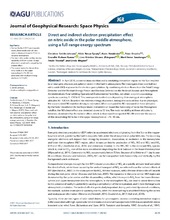Direct and indirect electron precipitation effect on nitric oxide in the polar middle atmosphere, using a full-range energy spectrum
Smith-Johnsen, Christine; Tyssøy, Hilde Nesse; Hendrickx, Koen; Orsolini, Yvan; Kishore Kumar, Grandhi; Ødegaard, Linn-Kristine Glesnes; Sandanger, Marit Irene; Stordal, Frode; Megner, Linda
Peer reviewed, Journal article
Published version

Åpne
Permanent lenke
https://hdl.handle.net/1956/17020Utgivelsesdato
2017Metadata
Vis full innførselSamlinger
Originalversjon
Journal of Geophysical Research - Space Physics. 2017, 122 (8), 8679-8693. https://doi.org/10.1002/2017ja024364Sammendrag
In April 2010, a coronal mass ejection and a corotating interaction region on the Sun resulted in an energetic electron precipitation event in the Earth’s atmosphere. We investigate direct and indirect nitric oxide (NO) response to the electron precipitation. By combining electron fluxes from the Total Energy Detector and the Medium Energy Proton and Electron Detector on the National Oceanic and Atmospheric Administration’s Polar-orbiting Operational Environmental Satellites, we obtain a continuous energy spectrum covering 1–750 keV. This corresponds to electrons depositing their energy at atmospheric altitudes 60–120 km. Based on the electron energy deposition, taking into account loss due to photolysis, the accumulated NO number density is estimated. When compared to NO measured at these altitudes by the Solar Occultation for Ice Experiment instrument on board the Aeronomy of Ice in the Mesosphere satellite, the NO direct effect was detected down to 55 km. The main variability at these altitudes is, however, dominated by the indirect effect, which is downward transported NO. We estimate the source of this descending NO to be in the upper mesosphere at ∼75–90 km.